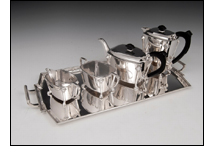featured item

doulton lambeth art nouveau sporting stoneware jug, circa... Read more
Antique Silver
Posted by Gill Jones on 30/10/2013
 Gandhi once said that health is the real wealth and not gold or silver. There’s a great deal of truth in that, however it’s nice to have some silver or gold too as well as your health, for who can resist a precious metal? Although gold has always been the more expensive metal and the most desired, silver seems to have that little bit more class, a little less shimmer and a bit more glimmer. It is a metal that exudes class and sophistication. It looks good on skin and looks good in whatever shape it has been moulded into, whether it is a simple ashtray or a grand teapot.
Gandhi once said that health is the real wealth and not gold or silver. There’s a great deal of truth in that, however it’s nice to have some silver or gold too as well as your health, for who can resist a precious metal? Although gold has always been the more expensive metal and the most desired, silver seems to have that little bit more class, a little less shimmer and a bit more glimmer. It is a metal that exudes class and sophistication. It looks good on skin and looks good in whatever shape it has been moulded into, whether it is a simple ashtray or a grand teapot.
It has a fine history in that it’s British hallmarking has been with us for over 600 years. From the beginning of the 14th century up until the late 15th an uncrowned leopard’s head adorned most silver in order to identify it from cheap metals. From Edward IV’s reign onwards a date and crowned leopard would be added as a hallmark, and with dated letters it meant that it was easier to date. In the sixteenth century the lion appeared facing left (known as passant guardant) to notify the buyer of its sterling standard, which was 92.5% pure silver. It changed to an uncrowned lion from the mid sixteenth century to the 19th and from 1821 onwards the lion was facing forward (passant).
The standard for pure silver was changed in the late 17th century from 92.5% to 95.8%, this would change as the higher standard was too soft. The 92.5% sterling was replaced as the higher standard. Most silver used to make jewellery and other silverware today is made from 92.5% sterling.
We may have hallmarked it for 600 years, but silver goes back even further as it has been used for 5,000 years. It comes from silver ores like argentite and horn silver along with other metal deposits such as led, copper and gold. Pure silver is the best for conducting heat and electricity; it’s also good for reflecting light and at one time silver was also used to make coins. Today, other metals have taken its place in people’s pockets.
If you’re looking for some antique silverware, what should you be looking for? If you want to make sure it’s pure silver you’re dealing with and that it’s free from faults and damage then having a good feel is probably the best thing. See it in person. Breathing on silver can reveal a multitude of faults including splits, joins (where there may have been a part snapped or replaced) and patches. Apparently, it can also help identify solder marks around the hallmarks if there have been any alterations to the original.
Feeling the object is a good idea, edges, and centres are places to aim for as are weak spots where there has been thinning of the metal. Place pressure on hallmarks to feel for fake ones that have been engraved on top of the originals. Weak areas will get weaker with age and cleaning so be careful.
There are some beautiful pieces on www.antiques.co.uk this week, which have been specifically chosen for their unique design and shape. Firstly, we have a silver tray from the Art Deco period made by Frank Cobb & Co. It comes with beautiful edging, corner angles and exquisite art deco handles. It’s quite beautiful and in excellent condition, it dates to around the early thirties.
Secondly we have a rather sweet Georgian silver fruit spoon, the inside of the ladle is silver gilt intricately decorated with fruit. The hallmarking sadly is not very clear, but it may have a London assay mark. However, the seller is confident that this is a Georgian piece of silverware. The handle is also beautifully decorated and it is an excellent piece from such a fascinating period.
Finally, we have a rather pretty Edwardian silver plate cake stand with three individual serving trays sitting within its own holder. It comes with exquisite laced edging identical on all three trays. It’s a beautiful piece and a rather grand affair if you intend using it to display your baking prowess!
Silver has been with us for thousands of years, we wear it, use it and display it, at one time we even spent it. It will never go out of fashion; it has class, elegance and just the right amount of glimmer.



